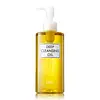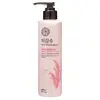What's inside
What's inside
 Key Ingredients
Key Ingredients

 Benefits
Benefits

 Concerns
Concerns

No concerns
 Ingredients Side-by-side
Ingredients Side-by-side

Water
Skin ConditioningParaffinum Liquidum
EmollientDipropylene Glycol
HumectantIsopropyl Myristate
EmollientDicaprylyl Ether
Emollient1,2-Hexanediol
Skin ConditioningOryza Sativa Extract
AbsorbentOryza Sativa Bran Oil
EmollientSaponaria Officinalis Leaf/Root Extract
Skin ConditioningCetearyl Olivate
Stearic Acid
CleansingSorbitan Olivate
EmulsifyingCaprylic/Capric Glycerides
EmollientPPG-26-Buteth-26
Skin ConditioningAcrylates/C10-30 Alkyl Acrylate Crosspolymer
Emulsion StabilisingPEG-40 Hydrogenated Castor Oil
EmulsifyingLithium Magnesium Sodium Silicate
AbsorbentSodium Cetearyl Sulfate
CleansingCaramel
Cosmetic ColorantPotassium Hydroxide
BufferingDisodium EDTA
Dextrin
AbsorbentButylene Glycol
HumectantTocopherol
AntioxidantPhenoxyethanol
PreservativeParfum
MaskingHexyl Cinnamal
PerfumingWater, Paraffinum Liquidum, Dipropylene Glycol, Isopropyl Myristate, Dicaprylyl Ether, 1,2-Hexanediol, Oryza Sativa Extract, Oryza Sativa Bran Oil, Saponaria Officinalis Leaf/Root Extract, Cetearyl Olivate, Stearic Acid, Sorbitan Olivate, Caprylic/Capric Glycerides, PPG-26-Buteth-26, Acrylates/C10-30 Alkyl Acrylate Crosspolymer, PEG-40 Hydrogenated Castor Oil, Lithium Magnesium Sodium Silicate, Sodium Cetearyl Sulfate, Caramel, Potassium Hydroxide, Disodium EDTA, Dextrin, Butylene Glycol, Tocopherol, Phenoxyethanol, Parfum, Hexyl Cinnamal
 Reviews
Reviews

Ingredients Explained
These ingredients are found in both products.
Ingredients higher up in an ingredient list are typically present in a larger amount.
Phenoxyethanol is a preservative that has germicide, antimicrobial, and aromatic properties. Studies show that phenoxyethanol can prevent microbial growth. By itself, it has a scent that is similar to that of a rose.
It's often used in formulations along with Caprylyl Glycol to preserve the shelf life of products.
Tocopherol (also known as Vitamin E) is a common antioxidant used to help protect the skin from free-radicals and strengthen the skin barrier. It's also fat soluble - this means our skin is great at absorbing it.
Vitamin E also helps keep your natural skin lipids healthy. Your lipid skin barrier naturally consists of lipids, ceramides, and fatty acids. Vitamin E offers extra protection for your skin’s lipid barrier, keeping your skin healthy and nourished.
Another benefit is a bit of UV protection. Vitamin E helps reduce the damage caused by UVB rays. (It should not replace your sunscreen). Combining it with Vitamin C can decrease sunburned cells and hyperpigmentation after UV exposure.
You might have noticed Vitamin E + C often paired together. This is because it is great at stabilizing Vitamin C. Using the two together helps increase the effectiveness of both ingredients.
There are often claims that Vitamin E can reduce/prevent scarring, but these claims haven't been confirmed by scientific research.
Learn more about Tocopherol